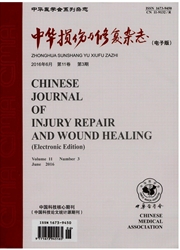

 中文摘要:
中文摘要:
目的观察严重烧伤后肝脏p38丝裂原活化蛋白激酶(mitogen—activated protein kinase,MAPK)对激活蛋白(activating protein,AP)-1和核因子(nuclear factor,NF)-κB的影响。方法采用30%TBSAⅢ度烫伤动物模型,健康成年的雄性SD大鼠24只,随机分为假烫组、烧伤对照组和烧伤+SB203580组。观察烧伤24h后肝脏IκBα含量的变化,并采用凝胶电泳迁移率变化分析(electrophoretic mobility shift assay,EMSA)法检测肝脏AP-1和NF-κB DNA结合活性的变化。结果大鼠烧伤24h后肝脏IκBα含量明显下降(2086±684 vs 4138±1160,P〈0.05),肝脏AP-1和NF-κB DNA结合活性均显著增强,使用p38MAPK抑制剂SB203580能显著抑制肝脏AP-1 DNA结合活性的上升(469±84 vs 1306±486,P〈0.01),但对肝脏IκBα含量和NF-κB DNA结合活性的变化无明显影响。结论严重烧伤后,肝脏中活化的p38MAPK通过激活转录因子AP-1进而引起细胞因子的产生,在烧伤后肝损伤的发生中起重要作用,p38MAPK这一作用与IκBα降解引起的NF-κB DNA结合活性增强无关。
 英文摘要:
英文摘要:
Objective To investigate the effect of p38 mitogen-activated protein kinase (MAPK) on the hepatic activating protein (AP) - 1 and nuclear factor (NF) -κB in severely burned rats. Methods Twenty-four adult healthy male rats were randomly divided into three groups: sham group, burn control group, and burn + SB203580 group. A third-degree burns over 30% total body surface area (TBSA) rat model was used and hepatic IκBα content at 24 hours postburn was measured. The DNA-binding activities of AP-1 and NF-κB in the liver were determined by electrophoretic mobility shift assay (EMSA). Results At 24 hours posthurn, the hepatic IκBα content of burn control group was significantly lower than that of sham group (2086 ±684 vs 4138 ±1160, P 〈0.05). Burn trauma also resulted in increased hepatic AP-1 and NF-κB DNA-binding activities. SB203580, an inhibitor of p38 MAPK, inhibited the DNA-binding activity of AP-1, but did not have any impact on the changes of hepatic IκBα content or NF-κB DNA-binding activity. Conclusions After burn injury, activation of p38 MAPK in the liver mediates the release of cytokines through the activation of AP-1 and contributes to burn-induced liver injury. This effect was not associated with the increased NF-κB DNA-binding activity resulted from the degradation of IκBα.
 同期刊论文项目
同期刊论文项目
 同项目期刊论文
同项目期刊论文
 期刊信息
期刊信息
